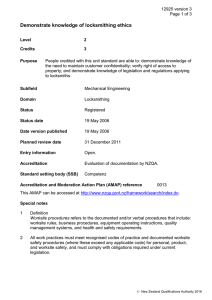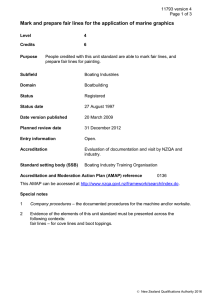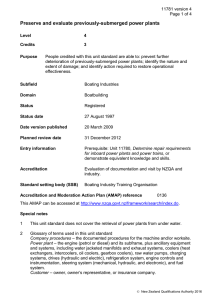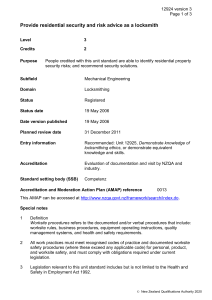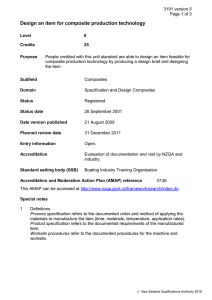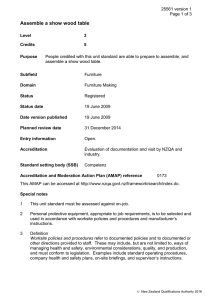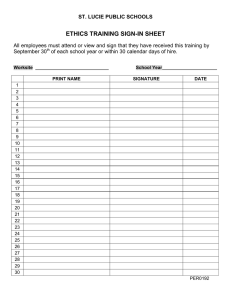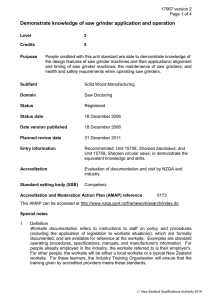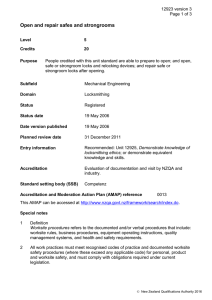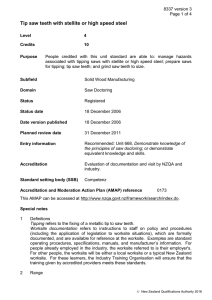Assemble and test key mechanisms
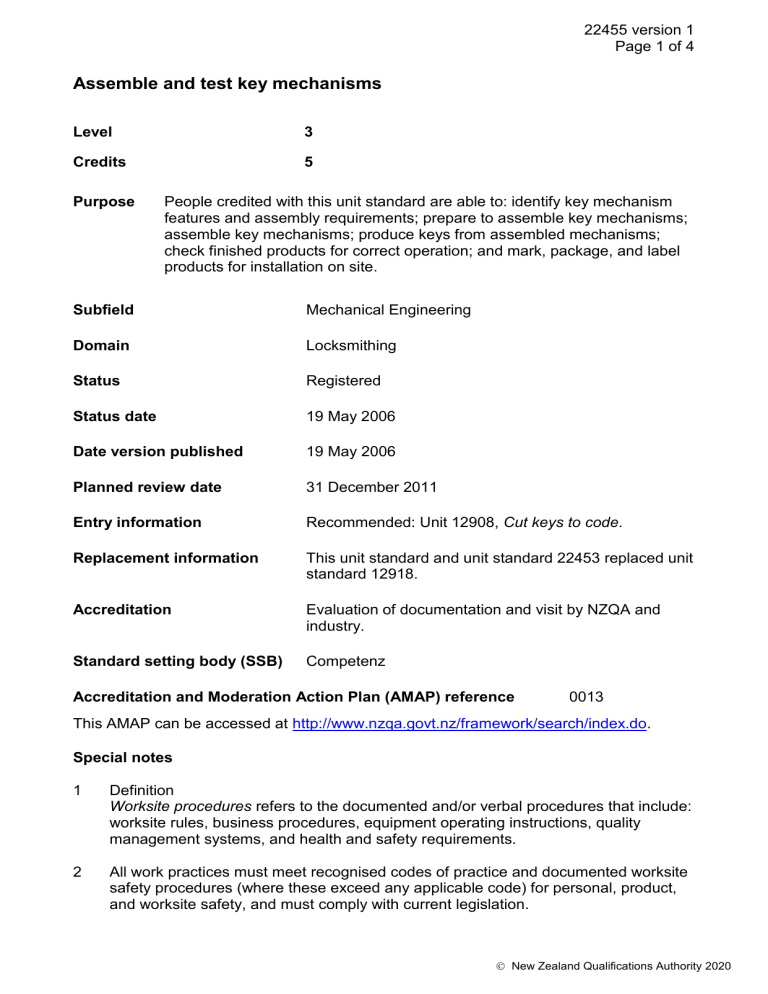
22455 version 1
Page 1 of 4
Assemble and test key mechanisms
Level 3
Credits 5
Purpose People credited with this unit standard are able to: identify key mechanism features and assembly requirements; prepare to assemble key mechanisms; assemble key mechanisms; produce keys from assembled mechanisms; check finished products for correct operation; and mark, package, and label products for installation on site.
Subfield Mechanical Engineering
Domain
Status
Status date
Date version published
Locksmithing
Registered
19 May 2006
19 May 2006
Planned review date
Entry information
31 December 2011
Recommended: Unit 12908, Cut keys to code .
Replacement information
Accreditation
This unit standard and unit standard 22453 replaced unit standard 12918.
Evaluation of documentation and visit by NZQA and industry.
Standard setting body (SSB) Competenz
Accreditation and Moderation Action Plan (AMAP) reference 0013
This AMAP can be accessed at http://www.nzqa.govt.nz/framework/search/index.do
.
Special notes
1 Definition
Worksite procedures refers to the documented and/or verbal procedures that include: worksite rules, business procedures, equipment operating instructions, quality management systems, and health and safety requirements.
2 All work practices must meet recognised codes of practice and documented worksite safety procedures (where these exceed any applicable code) for personal, product, and worksite safety, and must comply with current legislation.
New Zealand Qualifications Authority 2020
22455 version 1
Page 2 of 4
3 Legislation relevant to this unit standard includes but is not limited to the Health and
Safety in Employment Act 1992.
Elements and performance criteria
Element 1
Identify key mechanism features and assembly requirements.
Performance criteria
1.1 Assembly specifications are identified from instructions and documentation.
Range required components and parts, door handing, time frame for completion, keying instructions, fitting requirements.
1.2 Appropriate authorisations are obtained, signatures checked, and order confirmed.
1.3 Appropriate assembly sequence and/or method is planned according to instructions.
Element 2
Prepare to assemble key mechanisms.
Performance criteria
2.1 Key mechanisms are disassembled, if necessary.
Range lever lock – mortise, safe, projection locks; wafer locks – lever handles, cam locks, padlocks; pin lock
– padlocks, door locks.
2.2 Components and parts are assembled according to manufacturer’s specifications.
Range wafers, springs, key blanks, plugs, levers, housings, pins, cams and screws, circlips and tails.
2.3 Tools, equipment and materials are selected to suit job requirements.
Range tools and equipment
– jigs, followers, tweezers, screwdrivers, circlip pliers, files, wire wheel; materials – graphite, teflon and silicone based lubricants.
2.4 Work area is prepared and components arranged according to worksite procedures and selected assembly technique.
2.5 Defective or faulty parts are identified and processed according to worksite procedures.
New Zealand Qualifications Authority 2020
22455 version 1
Page 3 of 4
Element 3
Assemble key mechanisms.
Performance criteria
3.1 Locksmithing techniques and principles are applied appropriate to assembly activity.
3.2 Records and data are maintained or processed according to worksite procedures.
3.3 Component parts are fitted to ensure correct positioning and conformance with manufacturer’s specifications.
3.4 Locking mechanism is correctly marked, tagged, or identified as appropriate according to worksite procedures.
3.5
Element 4
Components or assembled mechanisms are handled and stored in a manner least likely to cause damage and according to worksite procedures.
Produce keys from assembled mechanisms.
Performance criteria
4.1 The key mechanism and construction is correctly identified using an appropriate method.
Range visual identification, disassembly, keyway, labelling.
4.2
4.3
4.4
Key mechanism is decoded (internal locking components).
Key blank, type, size and position of key cuts is determined.
Appropriate cutting method is selected.
Range may include mortise machine, clipper, code machine, depth and spacing keys.
4.5 Keys are produced and tested to ensure correct operation.
Element 5
Check finished products for correct operation.
Performance criteria
5.1 Operation of cylinder and key is checked for conformance to man specifications. ufacturer’s
New Zealand Qualifications Authority 2020
22455 version 1
Page 4 of 4
5.2 Faults in cylinder or key operations are identified and rectified.
Element 6
Mark, package, and label products ready for installation on site.
Performance criteria
6.1 Stamping equipment is selected and used correctly.
Range may include dedicated stamping machine, hand stamps, stamping block, engraver.
6.2 Products are stamped with correct door and key reference information according to worksite procedures.
Range key system number, rank, key issue, dealer identification.
6.3 Products are grouped, packaged and labelled for installation according to worksite procedures.
Please note
Providers must be accredited by the Qualifications Authority, or an inter-institutional body with delegated authority for quality assurance, before they can report credits from assessment against unit standards or deliver courses of study leading to that assessment.
Industry Training Organisations must be accredited by the Qualifications Authority before they can register credits from assessment against unit standards.
Accredited providers and Industry Training Organisations assessing against unit standards must engage with the moderation system that applies to those standards.
Accreditation requirements and an outline of the moderation system that applies to this standard are outlined in the Accreditation and Moderation Action Plan (AMAP). The
AMAP also includes useful information about special requirements for organisations wishing to develop education and training programmes, such as minimum qualifications for tutors and assessors, and special resource requirements.
Comments on this unit standard
Please contact the Competenz qualifications@competenz.org.nz
if you wish to suggest changes to the content of this unit standard.
New Zealand Qualifications Authority 2020
